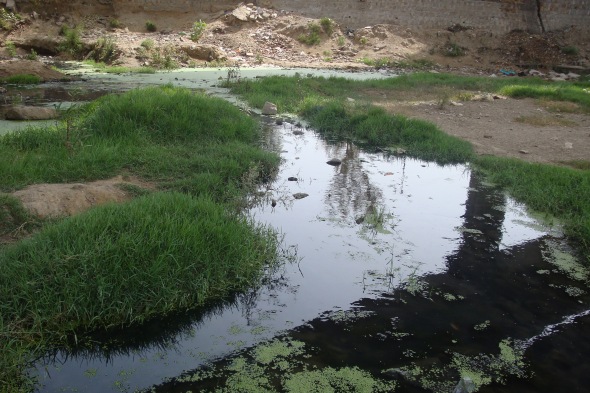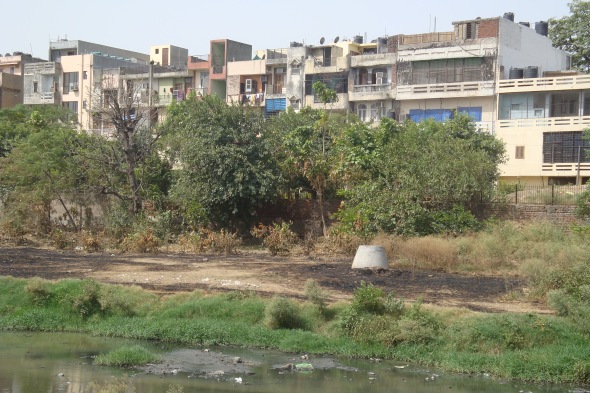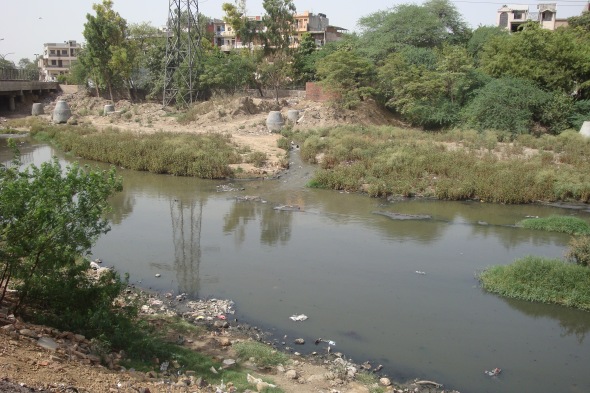– by Shruti Syal
It’s a taunt, really, this site. Vast expanses of EXACTLY what you’d want at such a site, that then bites at you because it’s too big for the budget of a pilot project.
We’ve inched closer to the Yamuna, the closest we’ve been in all our site visits so far. Just south of Isa Khan’s tomb, beyond Nizamuddin East, is a fairly broad drain that empties directly into the river. Buried behind a thicket of dry vegetation is the huge site, its magnitude visible only once you get down there. The drain runs along the length of the metro track, and is gifted in terms of both area and site vegetation. Water runs deeper than those we’ve seen so far, definitely over 1 metre, and breaks off into little shallow pools littered with standing, half submerged vegetation and duckweed. We decided not to venture further upstream than Barapullah Road:
At the assumed head under Barapullah Road, the flow is clearly the roughest we’ve seen, due in no small measure to the size of the drain.
Standing agape, we get excited at the prospect of this site, and we’re as yet to be exposed to its full splendour. We consider going back for our makeshift sampling gear, but the sheer size of the drain makes us realize it’s too big for our budget. We walk along anyway, soaking in the sights as well as the sun. No, wait, heat.
Barking dogs halt our progress for a few minutes, minutes we choose to moan at how lovely this site could look with a large investment. Native vegetation dominates the landscape, and the northern bank of the drain has gorgeous undulations that can be worked into an easy hike. The ‘shore’ across also looks promising, save perhaps, for the power lines.
Venturing into a spot with a fuller view of the drain, I crane back for a 360-degree view of the place, and my eyes wander onto a delicate trail of water scattered with a fine blanket of duckweed, and banked by mounds of lush green grass.
The view up ahead makes this look more like a river tributary than a drain, and garbage, what garbage?? Still, the maps and GPSes tell us we’re on track.
It’s the kind of site that makes you wonder if it falls under some kind of project by the government. We didn’t ask around, so much of our understanding of the site is based on educated guesses and the minute experience we’ve accrued since we started on the journey.
Up ahead is probably a sewer line, and we leave behind the picturesque little bend in the metro line.
Hopping up to the main road, I get a better view of the supposed sewer line:
And then I catch a glimpse of a feature I’ve come to love at all drain sites, inlets.
This is also the spot where the drain narrows, just as intimated in the maps.
One important bit to learn about this site is the location of the STP sending in all this water.
We finally hit the mandi, and look past the fencing on the little bridge to the settlement, or settlements? Sant Nagar, Devi Nagar and Kali Basti, read the maps. Here’s where we choose to halt before heading off to other sites where we might actually be able to do something.
On the plus side, train carriage. Hoot.


















Really the world need to know about places like this. I have something similar in Nigeria. I really appreciate ur efforts. Pls keep posted on every progress.
Thanks! What are you working on?
And do keep pace with the blog, I know things have been on the down-low for a year, but we will have updates every month or two, and a year later there will be data from a pilot research stint in Summer 2014.
I am an archi student (SPA, Delhi), quite aware of this site. I am working on understanding the drainage vs the green relationship of Delhi. I feel this area to be quite viable for root canal treatment, but it seems that the existence of barapullah road might not allow that.
Yes, that was our thought as well.
Please do keep pace with the blog, I know things have been on the down-low for a year, but we will have updates every month or two, and a year later there will be data from a pilot research stint in Summer 2014.
Thank you guys for the interest! What is “root canal treatment”? And if you’re interested in what ACWUS is doing (have you read our other posts and seen some of the profiled sites?), we can talk more via info.acwus@gmail.com